Carnivorous plants are an endless source of fascination for scientists and non-scientists. These plants derive nutrients from capturing and digesting animals, usually insects and other arthropods. The possibility that plants could eat animals has been debated for many years and has inspired several books and movies.
Carnivorous plants are spread throughout various taxa in angiosperm clades, linked by the botanical carnivory ecological niche. True carnivory is thought to be represented by more than a dozen genera, having evolved independently about 12 times in five distinct orders of flowering plants.
Aspects of their evolution, including rapid responses to nutrient requirements and additions, and development preformation, make carnivorous plants well-suited for addressing basic questions in biology, such as diet preference and population forecasting.
This article examines eight of the carnivorous plants that eat bugs.
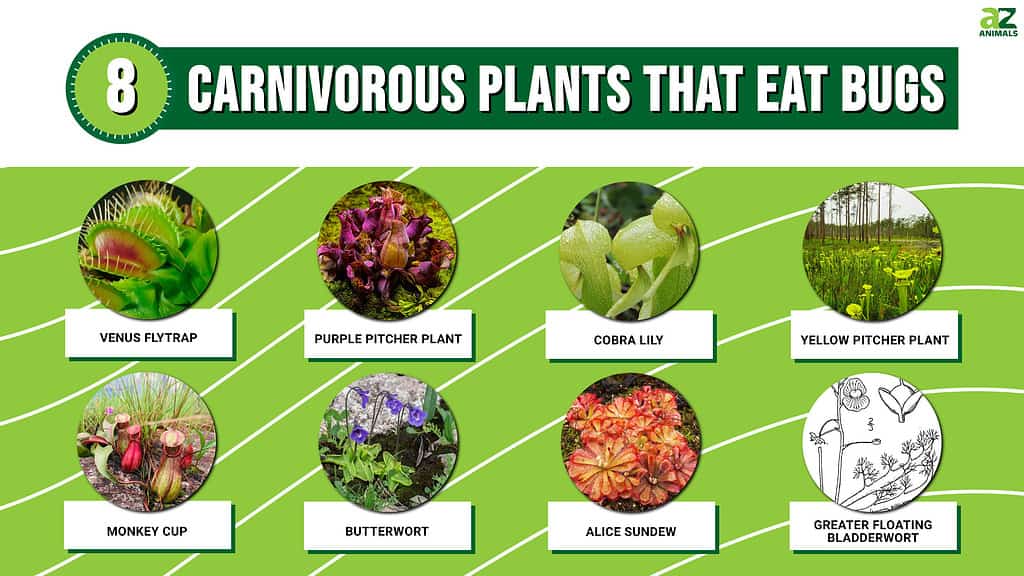
Read on for more information about these uniquely divergent plants.
1. Venus Flytrap

The Venus flytrap is one of the most common carnivorous plants native to subtropical wetlands.
©sawinimages/Shutterstock.com
| Venus Flytrap | |
|---|---|
| Scientific Name | Dionaea muscipula |
| Color Varieties | Red, white, and green |
| Height | 6-12 inches (15-30 cm) |
| Habitat | Wetlands |
The Venus flytrap is one of the most common carnivorous plants native to subtropical wetlands. Its main prey consists of insects and arachnids. It has a trapping structure formed by the leaves’ terminal portion, often triggered by sensitive micro receptors on their inner surfaces. An action potential is triggered via an electric network when an unsuspecting bug crawls along the leaves and its tiny hairs.
2. Purple Pitcher Plant

The purple pitcher plant is a carnivorous plant of the family
Sarraceniaceae.
©Fox Traveler/Shutterstock.com
| Purple Pitcher Plant | |
|---|---|
| Scientific Name | Sarracenia purpurea |
| Color Varieties | Green, red, and purple |
| Height | 6-18 inches |
| Habitat | Prefer wet sunny locations and grow in nutrient-poor, acid bogs |
The purple pitcher plant is a carnivorous plant of the family Sarraceniaceae. Like other pitcher plants, Sarracenia purpurea derives its nutrients through prey capture. It captures unsuspecting bugs with a pitfall trap that relies heavily on a micro-structured, slippery surface.
3. Cobra Lily
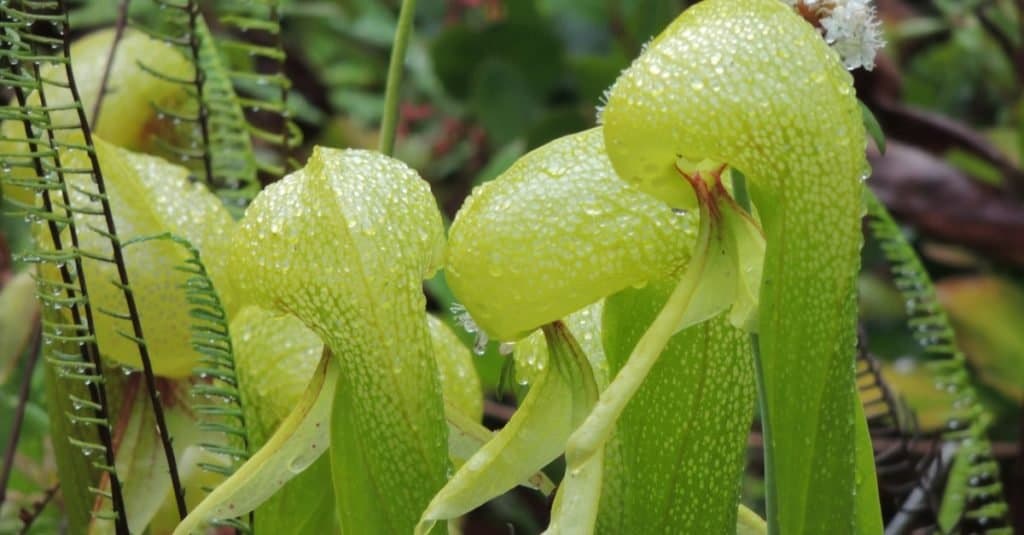
The cobra lily is a carnivorous plant in the family
Sarraceniaceae.
©Arty Alison/Shutterstock.com
| Cobra Lily | |
|---|---|
| Scientific Name | Darlingtonia californica |
| Color Varieties | Range from yellow to purplish-green |
| Height | Grow up to about 2 feet tall |
| Habitat | Native to swamps in mountain areas of southern Oregon and northern California |
Cobra lily, best known as the California pitcher plant, is a carnivorous plant in the family Sarraceniaceae. It’s commonly found in bogs and seeps with cold running water. Unlike other members of the pitcher plant family, Darlingtonia californica has a distinct closed top and does not collect water, a mechanism used by other pitcher plants to create a digestive brew that dissolves the insects. Instead, cobra lilies are well adapted to physiologically pumping water into the trap to keep the fluid at an ideal ion concentration.
The translucent cobra lily leaves often confuse bugs. The unsuspicious bugs think they’re escaping the trap when in fact, they’re moving deeper inside.
4. Yellow Pitcher Plant
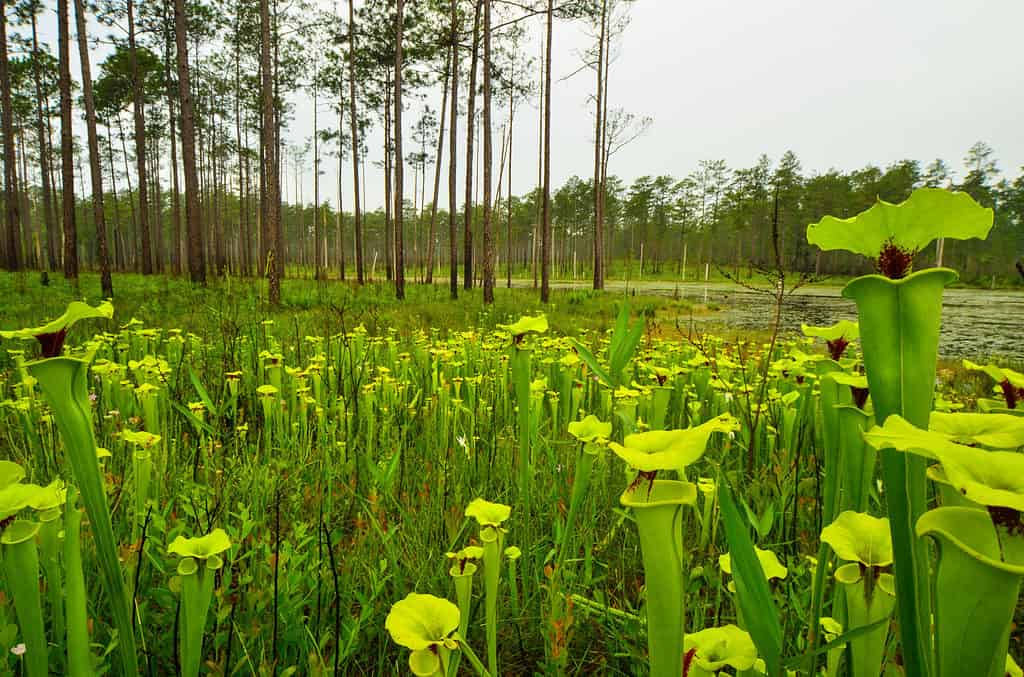
The yellow pitcher plant traps bugs using a rolled leaf.
©iStock.com/cturtletrax
| Yellow Pitcher Plant | |
|---|---|
| Scientific Name | Sarracenia flava |
| Color Varieties | Have bright yellow flowers and green trumpet-shaped leaves |
| Height | 18-36 inches |
| Habitat | Wet pinelands and bogs |
The yellow pitcher plant is another pitcher plant in the family Sarraceniaceae. Like most pitcher plants, It traps bugs using a rolled leaf. Its leaves fill with rainwater, and the uppermost part of the leaf is dilated to prevent excessive rainwater from diluting the digestive secretions within the pitcher. Once a bug flies in, it cannot fly out.
5. Monkey Cup
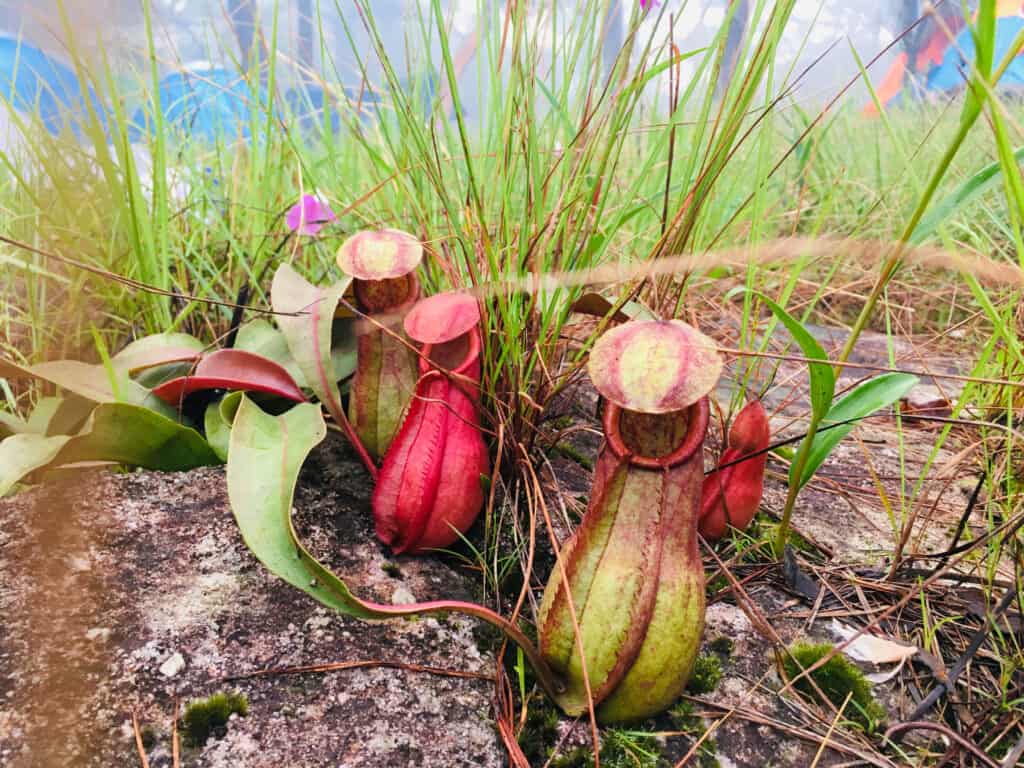
Monkey cup is a carnivorous plant in the family
Nepenthaceae.
©iStock.com/GinkMusaico
| Monkey Cup | |
|---|---|
| Scientific Name | Nepenthes |
| Color Varieties | Green, brown, and red |
| Height | Climbing stems can grow up to 49 feet, depending on the type |
| Habitat | Tropical regions of Southeast Asia, Australia, and Madagascar |
Monkey cup, also known as the tropical pitcher plant, is a carnivorous plant in the family Nepenthaceae. The name “monkey cup” is derived from the fact that monkeys were thought to drink rainwater from these pitcher plants.
Money cup acts as a passive insect trap and produces numerous groups of digestive enzymes to break down bugs and acquire nutrients upon enzymatic digestion.
6. Butterwort
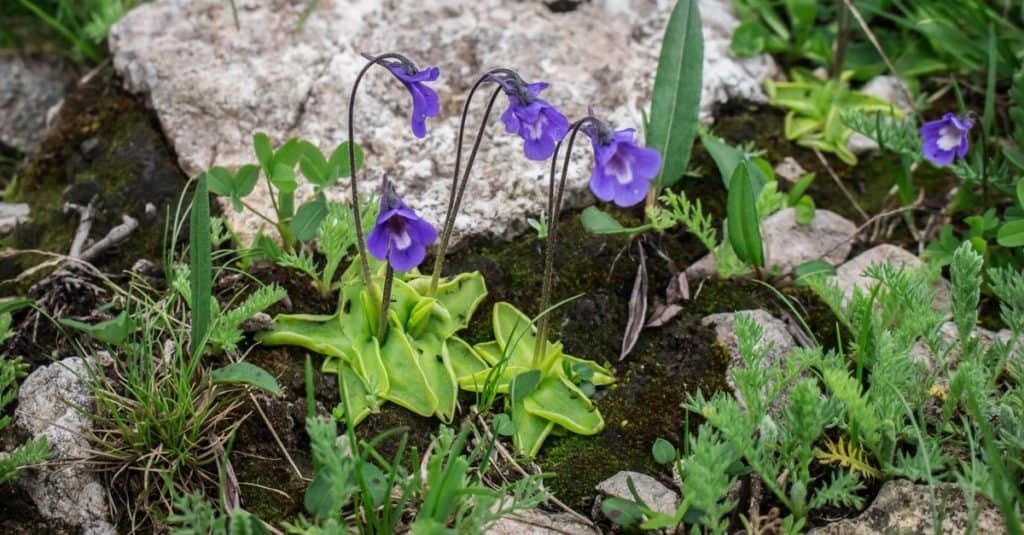
Butterwort is a carnivorous plant in the family
Lentibulariaceae.
©IvanaStevanoski/Shutterstock.com
| Butterwort | |
|---|---|
| Scientific Name | Pinguicula |
| Color Varieties | Blue, violet, or white with a yellow, greenish, or reddish tint |
| Height | 2-6 inches when it flowers |
| Habitat | Moist areas, such as fens, bogs, wet heaths, and rock crevices |
Butterwort is a carnivorous plant in the family Lentibulariaceae. It has sticky hairs that help lure, trap, and digest bugs. Apart from eating bugs, butterwort can also acquire nutrients from pollen landing on their leaves. It’s thought that the Pinguicula glands undergo autophagy in response to prey capture.
7. Alice Sundew
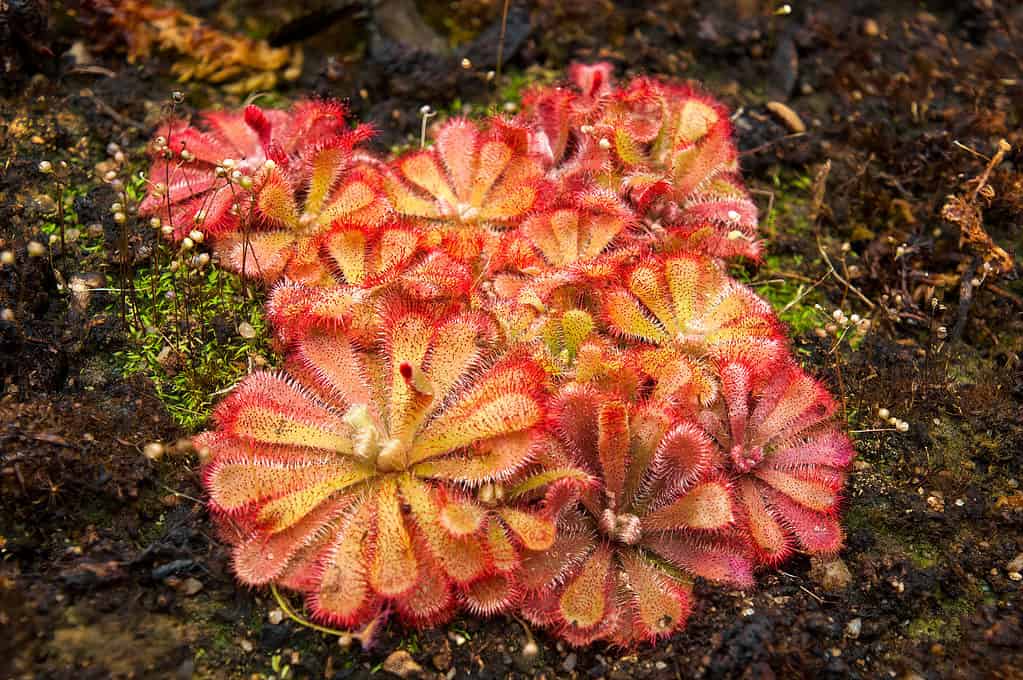
Alice sundew is a carnivorous plant in the family
Droseraceae.
©iStock.com/Karin de Mamiel
| Alice Sundew | |
|---|---|
| Scientific Name | Drosera aliciae |
| Color Varieties | Red, orange, yellow, or metallic violet |
| Height | Up to 10 inches |
| Habitat | Prefers moist habitats with acidic soils; South Africa. |
Alice sundew is a carnivorous plant in the family Droseraceae. Like the Drosera capensis, Drosera aliciae is one of the most commonly cultivated sundews. It produces attractive scapes of reddish flowers, which play a key role in attracting bugs.
Thirsty bugs are attracted to what seems like raindrops on the leaves. However, the watery substance is actually a glue-like material that traps insects. After digesting its prey, the leaves unfurl to set another trap.
8. Large Floating Bladderwort

Bladderworts have bag-like bladders that serve as traps.
©Britton, N.L., and A. Brown / public domain – License
| Large Floating Bladderwort | |
|---|---|
| Scientific Name | Utricularia inflata |
| Color Varieties | Bright yellow flowers |
| Height | About 8 – 40 inches |
| Habitat | Aquatic environments, such as swamps, ditches, and lakes; native to southeastern coastal plains of the United States; invasive in Washington. |
The large floating bladderwort, commonly known as inflated bladderwort or swollen bladderwort, is a large aquatic carnivorous plant of the family Lentibulariaceae. The state of Washington lists it as one of the most problematic aquatic plants due to its dense mat-forming habit. It’s among the few invasive carnivorous plants.
Bladderworts have bag-like bladders that serve as traps. They are about the size of a pinhead, used to trap very small animals like tiny crustaceans, newly hatched tadpoles, and mosquito larvae.
Summary of the 8 Carnivorous Plants That Eat Bugs
| Name of Plant | Location | Habitat |
|---|---|---|
| Venus Flytrap | Native to North and South Carolina; introduced to Florida and New Jersey and others. | Wetlands |
| Purple Pitcher Plant | Canada and north-eastern United States | Wet, sunny locations and nutrient-poor, acid bogs. |
| Cobra Lily | Southern Oregon and northern California. | Bogs and seeps with cold running water. |
| Yellow Pitcher Plant | Southern Alabama, Florida, Georgia, and coastal plains of southern Virginia, North Carolina, and South Carolina. | Wet pinelands and bogs. |
| Monkey Cup | Southeast Asia, Australia, and Madagascar. | Tropical regions |
| Butterwort | All of the Northern Hemisphere; mostly Mexico, Central America, and South America. | Moist areas, such as fens, bogs, wet heaths, and rock crevices, particularly in the mountains. |
| Alice Sundew | South Africa | Moist habitats with acidic soils. |
| Large Floating Bladderwor | Native to southeastern coastal plains of the United States; invasive in Washington. | Aquatic environments, such as swamps, ditches, and lakes. |
The photo featured at the top of this post is © Menno van der Haven/Shutterstock.com
Sources
- University of Arkansas Division of Agriculture, Available here: https://www.uaex.uada.edu/yard-garden/resource-library/plant-week/lily-cobra-9-2-11.aspx
- USDA, Available here: https://www.fs.usda.gov/wildflowers/plant-of-the-week/sarracenia_flava.shtml
- Missouri Department of Conservation, Available here: https://mdc.mo.gov/discover-nature/field-guide/bladderworts
- National Library of Medicine, Available here: https://www.ncbi.nlm.nih.gov/pmc/articles/PMC2634039/
Thank you for reading! Have some feedback for us? Contact the AZ Animals editorial team.






